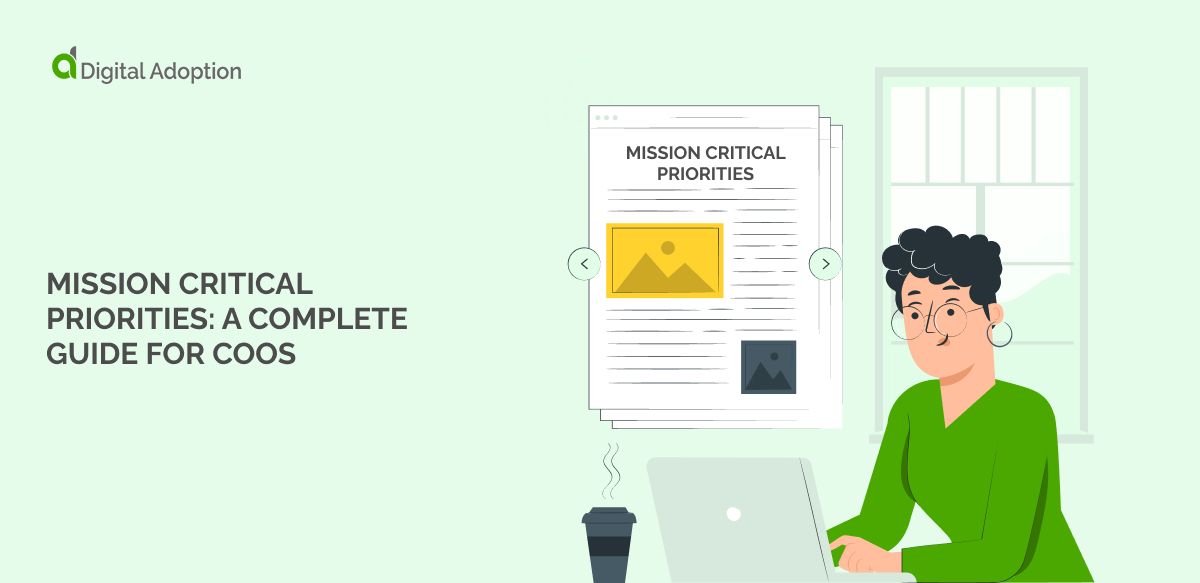As part of our Digital Adoption Trend Report, we are exploring the most pressing mission critical priorities for Chief Operating Officers (COOs) to focus on in 2023.
The impact of new technologies, macroeconomic disruptions, and an increasingly digitally-driven culture means the prerequisites for business success are ever-changing. Business leaders must respond quickly and keep their finger on the pulse of external factors, ensuring the organization is on the best course for longevity.
In 2023, digital adoption of artificial intelligence (AI), blockchain technology, and cloud computing are accelerating static business processes, work-from-home and hybrid work models are more popular than ever, and increasing customer demand for digital solutions remains fever-pitch.
As such, mission critical priorities (MCPs) are emerging as a key component driving various industries’ successful digital transformation (DX). By clearly defining which areas are the most important, businesses can focus on optimizing their resources and ensuring they deliver the highest value.
With so many competing factors, honing in on core business objectives and aligning them alongside established mission-critical priorities is a sure way for an organization to identify the most tailored routes to success. Ultimately, mission-critical priorities serve as a framework to guide decision-making and direct resources toward successful outcomes, and when adhered to, they can save businesses time and money.
This article will provide COOs with a complete understanding of mission-critical priorities, including the benefits and how they help increase operational velocity. We’ll also provide examples of mission-critical failures, how to avoid them, key tips when establishing essential priorities, and solutions that help identify, streamline, and implement MCPs for COOs at the helm of transformations.
- What Are Mission Critical Priorities?
- Why Are Mission Critical Priorities Important?
- Mission Critical Priorities vs. Business Critical Priorities
- Mission Critical Priorities Failures
- Developing Mission Critical Priorities
- Mission Critical Priorities For COOs
- Harness the Power of Mission Critical Priorities for Your Organization’s Future Success
- Mission Critical FAQs
What Are Mission Critical Priorities?
Mission-critical priorities are the core goals and objectives that guide the operations of any business or organization. These objectives provide a framework for setting realistic expectations and efficiently allocating resources to achieve desired outcomes.
By understanding mission critical priorities, businesses can focus their efforts on taking strategic actions and effectively track progress toward a goal. Doing so can save time and money while ensuring they remain on track with their objectives. Mission-critical priorities enable businesses to stay organized, understand their direction, and strive for success.
The phrase “mission critical” refers to the importance of a system or business process in achieving mission objectives. It is often used to describe mission-critical applications, systems, or projects essential for business survival. The origins of mission-critical business can be traced back to the military, where mission-critical activities were crucial for mission success. When a mission-critical system or system malfunctions, its impact on the organization is drastic and can bring operations to a halt.
Why Are Mission Critical Priorities Important?
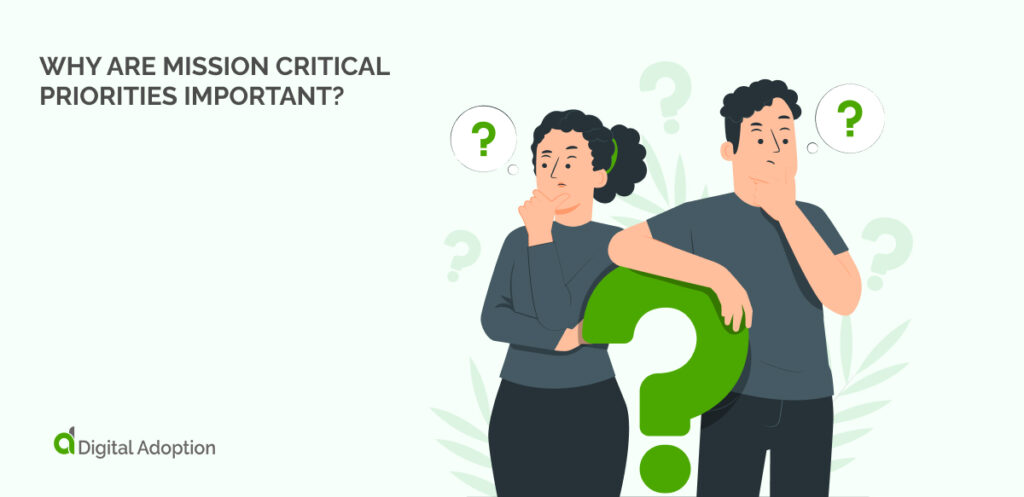
Mission Critical Priorities are essential to any organization or business as they provide a structure and decisive mission objectives, helping to provide clarity and focus.
Companies establish mission critical priorities to ensure their operations are aligned with the organization’s core objectives. These objectives provide a clear understanding for all team members of what is expected and how resources should be allocated efficiently. This allows employees and stakeholders to understand their roles and tasks, as well as how their actions are helping the organization to achieve mission objectives.
By creating a framework that sets expectations, focuses resources on the most strategic actions, and efficiently tracks progress toward a goal, mission-critical priorities can also help Chief Operating Officers (COOs) increase operational velocity. Prioritizing the most important tasks and activities ensures that all available resources are used effectively, resulting in improved efficiency and increased business speed in a shorter timeframe.
Mission Critical Priorities vs. Business Critical Priorities
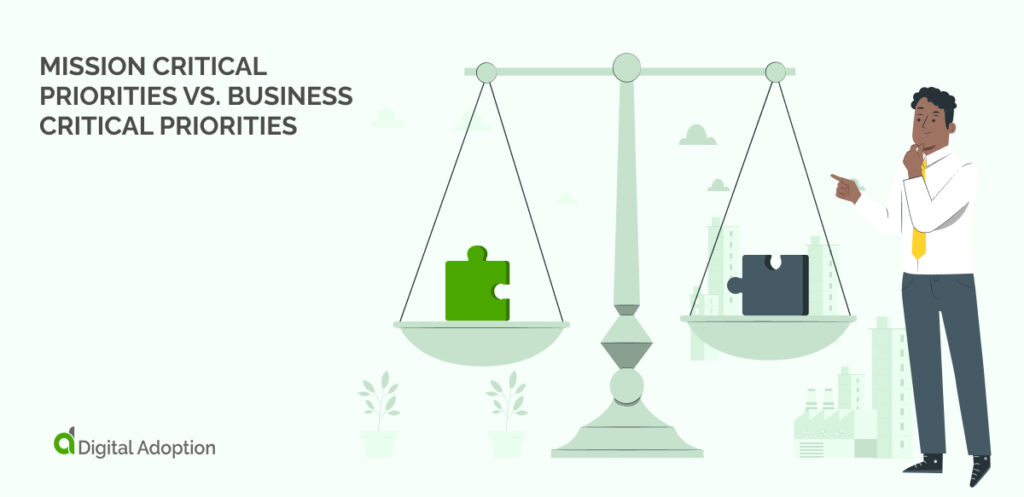
Mission-critical priorities can be characterized as tasks or goals that must be achieved to ensure the success of a project or organization. Examples of mission-critical activities can include launching a new product, delivering on time and within budget for a significant undertaking, meeting customer service expectations, and ensuring data security and compliance. These activities must be completed for the business to achieve its key objectives.
Business critical priorities refer to tasks or goals that are important to an organization’s operation and performance but are not necessarily essential for its core mission. Mission-critical business activities include improving profitability through cost-cutting measures, developing new operational efficiencies, increasing marketing effectiveness, and expanding into new markets.
Mission-critical and business-critical priorities share common elements, such as problem-solving skills and strategic planning. However, there are distinct differences between them. Mission-critical tasks demand quick action with minimal room for error, while business-critical tasks require more long-term planning and implementation strategies.
Additionally, while mission-critical tasks must be completed to ensure the success of a project or organization, business-critical tasks do not necessarily have this requirement – they simply make up a part of the organizational strategy.
Different scenarios will call for various combinations of mission and business-critical priorities. For example, when launching a new product, all mission-critical activities must be fulfilled to ensure successful market entry (e.g., meeting deadlines). However, it is also essential to consider the unique benefits offered by business-critical activities such as brand outreach campaigns and customer loyalty initiatives, which may contribute positively to product launch success even if not directly related to its core mission.
Mission Critical Priorities Failures
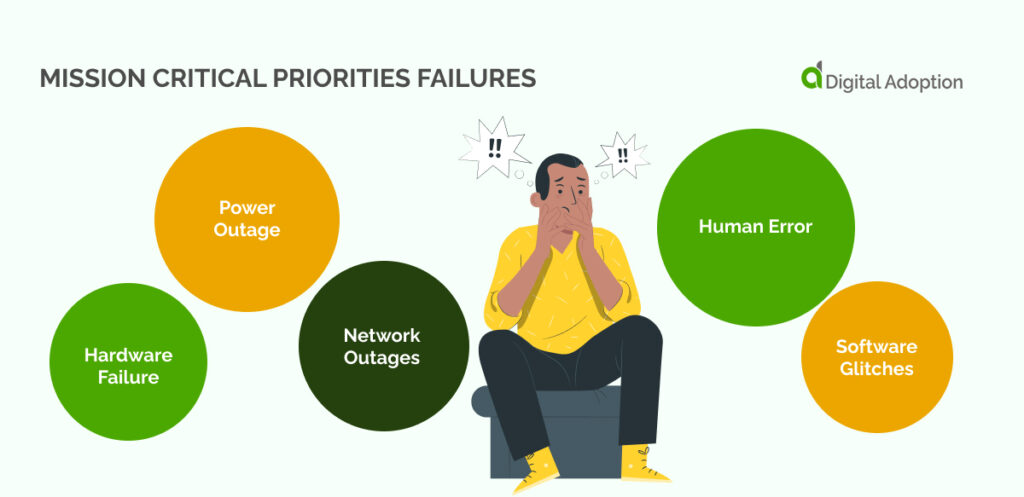
When achieving mission critical success, any failure can negatively impact a business’s goals. In this article, we’ll explore five of the most common mission critical failures and how setting critical priorities can help mitigate them concerning overarching business priorities.
Hardware Failure
Hardware failures are one of the most common mission critical failures. This type of failure occurs when the physical components within a system fail or experience significant damage due to environmental issues or improper maintenance. Common examples of hardware failure include overheating components, damaged circuit boards, faulty hard drives, and more.
To help mitigate hardware failures, organizations should prioritize component quality assurance to reduce risk and regularly schedule preventative maintenance checks on all equipment.
Power Outage
Power outages can often lead to mission critical failure if proper steps are not taken in advance. This type of failure occurs when an organization’s power source fails without warning due to storms, power grid fluctuations, or technical errors.
To address this risk, businesses must prioritize backup generation systems such as diesel generators or solar panel arrays that provide emergency power in case of a major outage and redundant infrastructure located offsite. This also helps prevent downtime during outages impacting mission-critical operations.
Network Outages
Network outages are another common cause of mission critical failure that businesses must be aware of. This type of failure usually occurs when an entire network has gone down due to poor maintenance practices or a lack of redundancy measures, such as multiple internet connections.
To reduce the likelihood of this happening, businesses must prioritize investing in tools such as Network Monitoring Software which helps detect any issues occurring on their networks before it’s too late. Opt for resources that allow you to restore service quickly if something goes wrong with your infrastructure.
Human Error
Human error is another leading cause of mission-critical failure and other business incidents, such as data breaches and security flaws due to incorrect configurations applied by technicians and general users accessing systems without the proper permissions or understanding their roles adequately.
To mitigate risks associated with human error effectively, organizations must prioritize setting up processes that provide users with clear instructions on using systems properly while limiting access privileges where appropriate so only those who need access get it rather than giving everyone within an organization blanket permission levels.
Software Glitches
Software glitches are another type of fault that needs business attention when it comes to mitigating potential losses during operations missions. The most common software glitches usually come from code bugs deployed into production environments after failing to test either because the test was inadequate or something changed between the development/testing phases that were not caught before deployment.
To lessen this risk, businesses must ensure that any changes to the software are thoroughly tested before going live and set up automated tests that detect any potential regressions, ensuring tasks like these don’t slip through cracks between different stages.
Developing Mission Critical Priorities
Solutions for addressing mission-critical priorities in both technology and IT cover a broad range of topics. Many answers are available, from improving system reliability and response times to developing secure communication protocols. The mission-critical priorities umbrella also encompasses other areas that require solutions outside of technology and IT, such as business continuity, financial compliance, employee security, customer experience, or even environmental impact.
For example, businesses need to ensure their systems are agile in responding to rapid changes in the market landscape or potential disruption caused by a pandemic. Companies can invest in technologies such as cloud computing to address this need for agility. Additionally, they must ensure that all employees have access to the right training and resources necessary to operate optimally under changing circumstances.
Financial compliance is another priority that falls within the mission-critical priority umbrella. Companies must develop solutions that ensure they are meeting legal requirements while also keeping up with industry standards. This may include investing in software solutions that monitor financial transactions or updating procedures and policies to reflect the latest standards regulators and industry bodies set.
Employee security is closely tied to operational effectiveness and efficiency; with proper security measures such as solid password management protocols, data encryption, malware control programs, and regular backups, businesses can confidently maintain their operations securely into the future. Companies must also protect customers from cyber threats by investing in solutions such as two-factor authentication services or creating detailed privacy policies outlining how customer data will be collected and used.
Apart from technology and IT, there are two other important things that people are talking about.
One is CXO strategies, which require changing products based on customer feedback to improve customer service. The other thing is environmental sustainability strategies. This means figuring out ways for organizations to reach their goals without harming the environment.
Both CXO strategies and environmental sustainability initiatives can provide benefits on multiple levels—including increasing brand loyalty among customers while helping organizations meet increasingly stringent legislation to preserve the environment for future generations.
Mission Critical Priorities For COOs
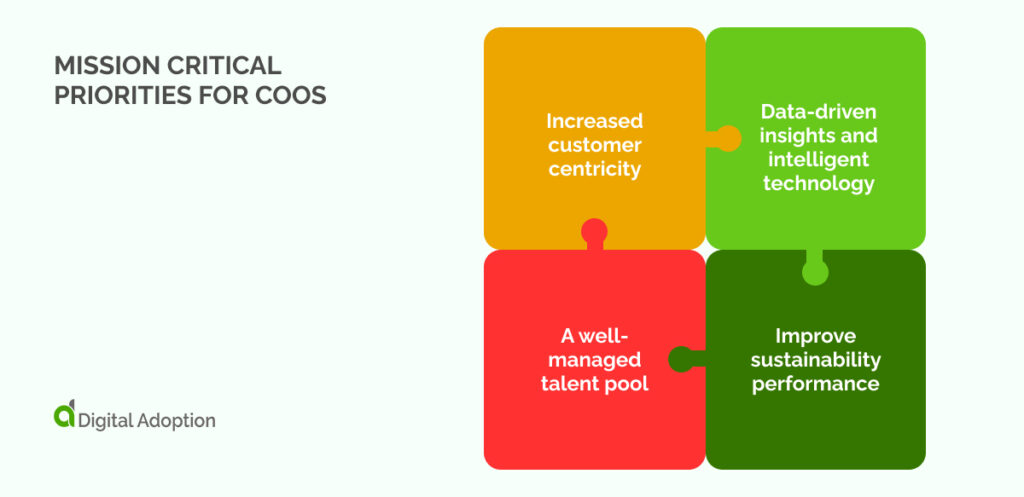
Chief operating officers (COOs) are trusted, reliable figures and are typically tasked with many responsibilities. Amongst safely overseeing and steering daily business operations, additional responsibilities include facilitating innovation, cultivating a healthy company culture, and shaping future goals and objectives. Let’s explore these priorities in depth.
- Increased customer centricity
- Data-driven insights and intelligent technology
- A well-managed talent pool
- Improve sustainability performance
Increased Customer-Centricity
Chief Operating Officers must prioritize customer-centricity to gain a competitive advantage in the marketplace. This means understanding customer needs, wants, and preferences and using that insight to create desirable products and services. Relevant data should be collected, analyzed, and utilized to develop effective marketing strategies. COOs should also continuously measure and evaluate customer service performance to ensure satisfaction and loyalty.
Data-Driven Insights and Intelligent Technology
Analytics are key for uncovering deeper customer insights as well as growth opportunities. Artificial intelligence (AI) can automate tedious processes, freeing up valuable time for teams to focus on more pressing matters. Data management strategies should also be deployed to organize information efficiently so it can be easily accessed.
A Well-Managed Talent Pool
COOs need a vast talent pool of employees with different skill sets who can work together effectively as a team. Recruiting the right people is essential but not enough – they must be carefully managed to get the best out of them. This includes providing guidance, feedback, support, and motivation so that employees reach their full potential while achieving organizational objectives.
Improved Sustainability Performance
Sustainability practices are becoming increasingly important for protecting the environment and reducing operational costs over the long term. Chief Operating Officers should ensure that sustainability initiatives are incorporated into company policies, procedures, and practices so that everyone knows their role in adhering to environmentally friendly standards. They also need to measure progress regularly to make necessary adjustments when required.
Harness the Power of Mission Critical Priorities for Your Organization’s Future Success
By leveraging an agile and flexible methodology for establishing MCPs, these priorities can improve efficiency, optimize resources, and provide the foundation for unbridled success.
For any organization hoping to have a successful future in business operations, it is important to understand the value of mission critical priorities. Companies should develop effective strategies and techniques that leverage MCPs to gain an advantage over competitors and build more robust techniques for continued growth.
In addition to providing a competitive edge, mission critical priorities help create an environment where business operations are safe from surprises or losses due to external factors such as natural disasters or industry shifts. Businesses can protect their investments by ensuring operational practices and processes run smoothly.
Mission Critical FAQs
- What are mission critical priorities (MCPs)
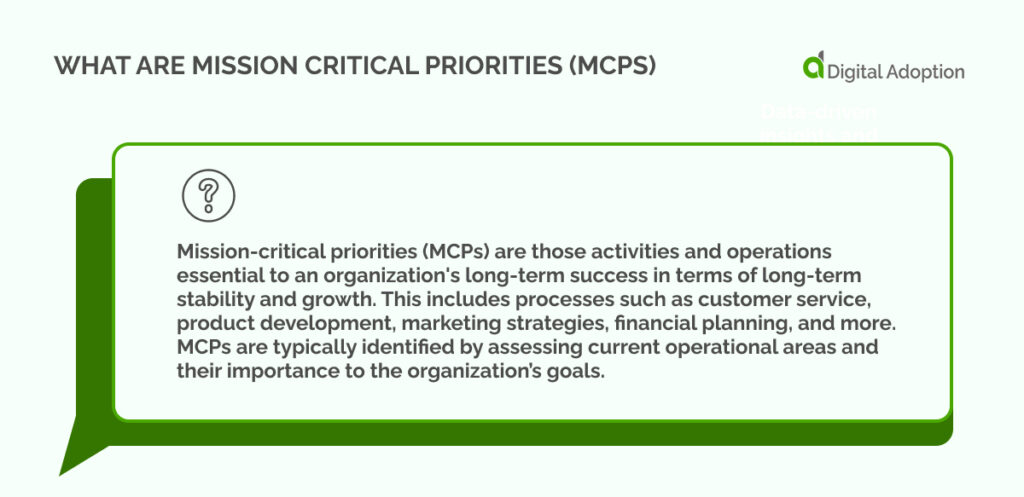
2. How can organizations create strategies for streamlining MCPs?
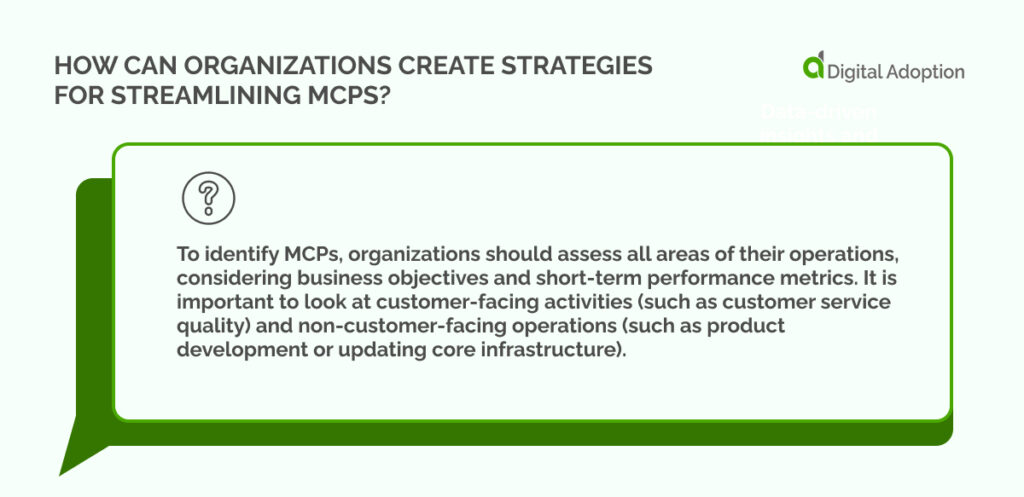
3. How does investing in identified MCPs benefit businesses?
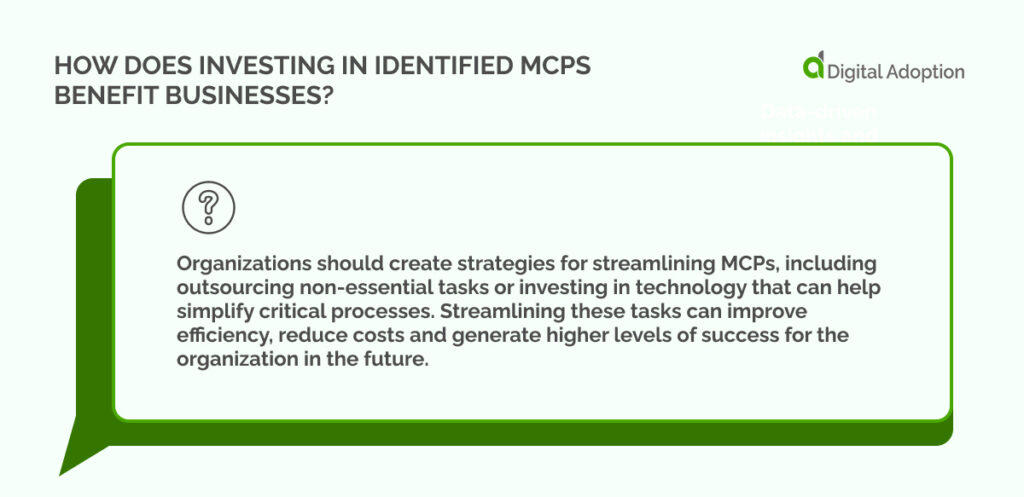
4. What competitive advantage can businesses gain by following the process of managing MCPs?
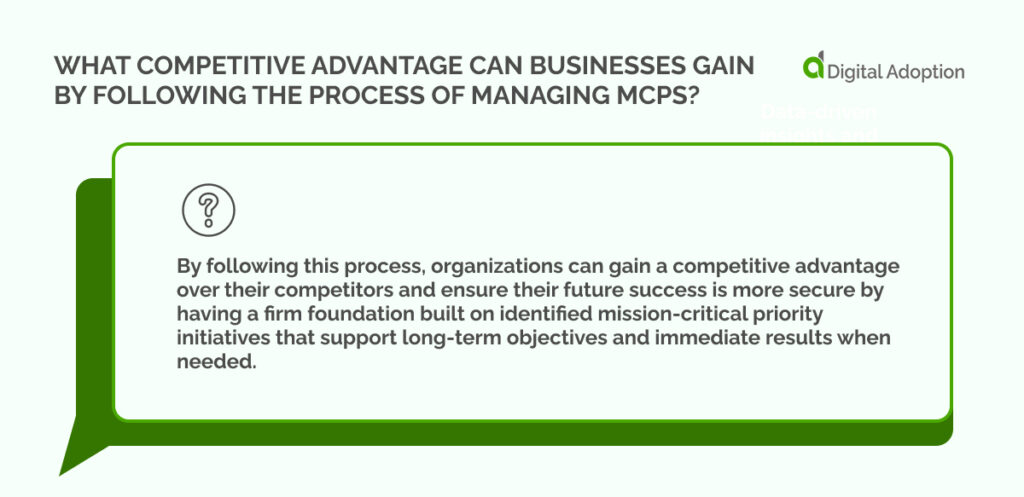
Q1 Answer: Mission-critical priorities (MCPs) are those activities and operations essential to an organization’s long-term success in terms of long-term stability and growth. This includes processes such as customer service, product development, marketing strategies, financial planning, and more. MCPs are typically identified by assessing current operational areas and their importance to the organization’s goals.
Q2 Answer: To identify MCPs, organizations should assess all areas of their operations, considering business objectives and short-term performance metrics. It is important to look at customer-facing activities (such as customer service quality) and non-customer-facing operations (such as product development or updating core infrastructure).
Q3 Answer: Organizations should create strategies for streamlining MCPs, including outsourcing non-essential tasks or investing in technology that can help simplify critical processes. Streamlining these tasks can improve efficiency, reduce costs and generate higher levels of success for the organization in the future.
Q4 Answer: By following this process, organizations can gain a competitive advantage over their competitors and ensure their future success is more secure by having a firm foundation built on identified mission-critical priority initiatives that support long-term objectives and immediate results when needed.

